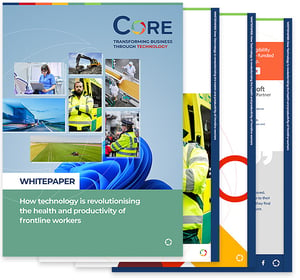If you’re wondering how to implement identity and access management (IDAM) in 2026, the answer starts with rethinking the way your organisation approaches trust, access, and authentication. Gone are the days of simple passwords and perimeter-based security — today, every identity, device, and request must be verified. That’s the essence of Zero Trust.
Modern IDAM isn’t just about controlling who gets in; it’s about proactively preventing breaches before they happen. With compromised credentials now linked to around 20% of data breaches (a 160% increase in 2025), businesses can’t afford to rely on outdated methods. Thankfully, tools like Microsoft Entra ID and Core, alongside protocols such as OAuth 2.0, SAML, and OIDC, make it possible to manage access securely across hybrid and cloud environments.
Let’s break down how to implement identity and access management effectively — from adopting a Zero Trust mindset to enabling multi-factor authentication (MFA) (which can block 99.9% of automated attacks).
Zero Trust: the foundation of IDAM in 2026
Zero Trust is at the heart of every strong IDAM strategy. The idea is simple: trust no one and nothing by default — not even users or devices already inside your network. Every login, access request, and transaction is continuously verified and assessed in real time.
Instead of granting broad access after one successful login, modern IDAM systems recheck trust for each action based on context — things like user role, device health, location, and behaviour. If something looks suspicious, the system can prompt for extra verification (like MFA) or block access altogether.
Least privilege access also plays a big role here. Users and applications only get the permissions they truly need, and only for as long as they need them. With tools like Role-Based Access Control (RBAC) and Attribute-Based Access Control (ABAC), you can tightly control who does what — even allowing temporary admin access through “just-in-time” privileges when necessary.
Modern IDAM platforms also use AI and analytics to detect unusual activity — for example, failed logins from new locations or sudden privilege escalations — and automatically respond to threats.
In practice, aligning IDAM with Zero Trust means:
- Using conditional access policies (e.g. triggering MFA when logging in from an unfamiliar device).
- Checking both user identity and device health before granting access.
- Requiring step-up authentication for sensitive actions, even after login.
With Zero Trust as your foundation, IDAM becomes more than just access control — it’s your frontline defence against stolen credentials and evolving cyber threats.
How to implement identity and access management
Implementing IDAM isn’t just about technology — it’s about aligning people, processes, and tools to build a secure, scalable foundation. Here are the key best practices for doing it right in 2026:
1. Develop a clear IDAM strategy and governance
Start by getting leadership on board and defining an IDAM strategy that supports your organisation’s goals. Set clear, measurable targets — for example, reducing how long it takes to create new user accounts or ensuring everyone uses MFA.
Create a cross-functional IDAM governance team that includes people from IT, security, HR, and compliance. This team will set the rules and oversee how IDAM is managed — things like who gets access to what, how approvals work, and how compliance is maintained. Establishing this structure early ensures everyone follows the same clear, consistent policies.
2. Adopt a phased implementation
Don’t try to do everything at once. Roll out IDAM in stages, starting with smaller, high-impact projects. For example, begin by enabling MFA and SSO for your most important applications, or onboard one department at a time.
Quick wins — like removing shared passwords or automating onboarding for a few apps — help prove value and build momentum. Once those early successes are in place, expand IDAM across the rest of the business gradually.
3. Automate the identity lifecycle
Streamline how user accounts are created, updated, and removed by connecting IDAM with your HR systems. When someone joins, their account should be set up automatically with the right permissions; when they change roles, access should adjust; and when they leave, it should be revoked immediately.
Automating this “joiner-mover-leaver” process reduces errors, removes old accounts, and saves time. Standards like SCIM make integration between IDAM, HR, and directories simple.
4. Enforce Least Privilege and Role-Based Access
Give users only the access they need to do their jobs — nothing more. Use RBAC to define standard access by job role, and add ABAC or temporary elevated access where extra precision is needed.
Schedule regular access reviews so managers can remove permissions no longer required. This helps prevent “privilege creep” over time.
5. Enable multi-factor and contextual authentication
MFA is essential for all users, especially administrators. Go a step further with contextual authentication — for example, requiring extra verification for logins from new devices, blocking access from risky locations, or only allowing certain apps on trusted devices. This smart approach strengthens security without making everyday logins a hassle.
6. Focus on user experience and training
IDAM should make users’ lives easier, not harder. Simplify access with SSO, so one secure login unlocks all their apps. Create a user-friendly portal to find everything in one place, and offer self-service tools for things like password resets and MFA setup.
Train users on new login methods and explain the benefits of added security. The easier and clearer the experience, the more likely users are to adopt and follow best practices.
7. Monitor and audit continuously
Keep a close eye on all identity-related activity. Log every login, privilege change, and admin action, and feed the data into your SIEM or monitoring tools. Use built-in analytics or AI to detect unusual behaviour — like an inactive account suddenly being used — and take action fast.
Regularly audit accounts, check MFA enforcement, and disable dormant profiles. Continuous monitoring not only boosts security but also helps meet compliance requirements (like GDPR or SOX).
8. Plan for the future
Your IDAM system should evolve as your business grows. Choose flexible, cloud-native solutions that can adapt to hybrid or multi-cloud environments and emerging technologies like IoT or microservices.
Keep up with trends such as Cloud Infrastructure Entitlement Management (CIEM) for managing cloud permissions and decentralised identity for user control.
Review your IDAM strategy regularly — at least once a year — to update it with new tools, analytics, and security standards.






